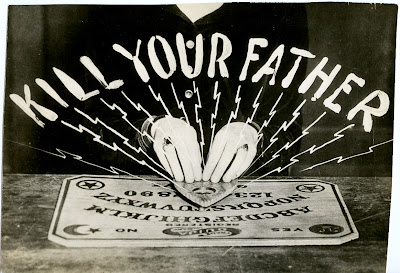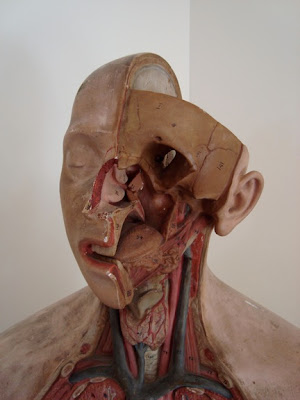
This seems somewhat appropriate given the economy!
Thursday, December 25, 2008
Sunday, December 14, 2008
Thursday, December 11, 2008
"Kill Your Father" says Ouija Board
From James Lamkin of Vintage Photographs.
Vintage press photograph depicting the story of Mattie Turley, a 15-yr old Arizona ranch girl, who claimed that a Ouija board her to "Kill Your Father!"
Here's a transcript from the period:
“Mother asked the Ouija board to decide between father and her cowboy friend. As usual the board moved around at first without meaning. Suddenly it spelled out I was to kill father. It was terrible. I shook all over.
Mother asked the Ouija if shooting would be successful and it said that it would; she asked if he would die outright and it said no. We asked what should be used and it said with shotgun. We asked if we would have the ranch and it said yes.
We asked about the law, and it said not to fear the law, that everything would turn out all right. We asked how much the insurance would be and it said $5,000.
I tried to kill him next day but I couldn't. I lost my nerve. A few days later though, I followed father to the corral. I raised the gun, took careful aim between his shoulders and then I lost my nerve again. But I thought of dear mother and what all this would mean to her and I couldn’t fail. My hand was trembling awfully though.
I raised the gun and fired.”
Circa 1930's Wolf's Head Motor Oil Teapot
Tuesday, December 9, 2008
Sunday, December 7, 2008
Folk Art Carved and Painted Portrait Bust of a Woman
Thursday, December 4, 2008
Page from a World War II Sailor's Scrapbook of the South Pacific
Monday, December 1, 2008
"The Time of All Nations"

An unusual 19th century cdv of a number of clock faces showing the time differences around the world. Cities include New York, St. Petersburg, Calcutta, Algiers, Sydney and Vienna.
19th century Folk Art Carved Doll
Saturday, November 22, 2008
Wednesday, November 19, 2008
Tuesday, November 18, 2008
Pair of Folk Art Carved Sculpted Plaster Female Figures, circa 1925
Sunday, November 16, 2008
Late 19th Century Painted Folk Art Balancing Toy

With articulated mouth.
Possibly Pennsylvania, late 19th century, the doll with painted wooden nodding head, tack eyes and nose, and articulated mouth, on a turned wooden base, dressed in a cotton sateen dress with lace trim, (wear), ht. 7 1/4 in.
Sold for $225.00 before premium at Skinner.
1860's CDV of Olive Oatman; Captured By Indians

Interesting circa 1860's cdv of Olive Oatman, a young Mormon woman who was captured by the Yavapai Indians in Arizona at the age of 13, sold to the Mojave, ransomed at Fort Yuma in 1856, and spent the rest of her life in NY and California.
Here's a brief biography found online:
Olive Oatman (1838-1903) was a woman from Illinois famous for her abduction and forced slavery by the Yavapai people (though many historians argue that it is impossible to know whether or not these were Yavapai, or some other tribe.[1]).
Born into the family of Roys and Mary Ann Oatman, Olive was one of eleven siblings, including an unborn one. She grew up in the Mormon religion.
Roys Oatman was a follower of James C. Brewster, a Mormon leader who convinced his followers that he had a divine call to take them to an imaginary territory named Bashan. Bashan was actually Arizona.
While on the way to Arizona, there were some misunderstandings between Brewster and some of his followers, and many of them, including the Oatman family, split from the group led by Brewster. Brewster actually ended up settling in California, once he was convinced that Bashan did not actually exist.
The Oatmans continued, commanded by Roys Oatman, to California. Oatman dreamed about becoming rich with California gold, despite several warnings that the area was dangerous due to the presence of Yavapai Indians who were always suspicious of whites entering their lands. By January, 1851, they reached Tucson, but their horses were suffering of hunger, as were members of the Oatman family.
They lost their horses and food to Apaches, but Roys Oatman was determined to reach California, so he continued on to Casa Grande, Arizona. Convinced by Dr. John Lawrence LeConte that Apaches had not been seen in some time around Yuma, Oatman continued his family's trip to California, despite severe hunger and thirst suffered by his pregnant wife and children.
The Oatman Tragedy:
In 1851 Olive Oatman saw her family masssacred on a lonely bluff overlooking the southern bank of the Gila river on the border between Mexico and the United States. Five of the victims were children, plus the mother who was eight months pregnant. Olive's father, Roys Oatman, could do little against the band of Indians who instigated the attack. Mary Ann Oatman, eight months pregnant, must have been wondering whatever possessed her to leave her home in Illinois. While the family finished their meal, a group of Indians suddenly appeared. Alerted to the new danger, Oatman eyed the Indians as they hunkered nearby and spoke quietly among themselves. At last the visitors gestured for food. Oatman, fearing reprisal, gave them what little food they had. The Indians devoured the meager supplies, then demanded more. When none was forthcoming, the marauders rifled through the wagon. This done, one Indian overpowered 13-year-old Olive, and 7-year-old Mary Ann before dragging the two young girls away. The rest of the Indians pulled clubs concealed inside their clothing and began beating the family members to death. Only 14-year-old Lorenzo would survive to tell what happened here.
Satisfied the family members were dead, the Indians stole what items they could carry, and destroyed the rest. They took off across the desert, taking the terrified Oatman girls with them. Mary Ann, who had always been a fragile child, soon fainted. The Indians beat her, but finally realizing she was unconscious and that brutality would do no good, one individual hoisted the limp child over his shoulder and the group continued their journey.
The captors were either Tolkepayas or Wester Yavapais living in a village nearly 100 miles from the massacre site. After arrival, the girls at first were threatened and tormented, Olive would later say she thought she would be killed. Eventually the girls were used as slaves to forage for food, lug water and firewood, and carry out whatever chores the Indian women chose for them to do. When the girls did not understand a command, they were beaten.
After a year of this drudgery, a group of Mohave Indians visited the village, and traded two horses, some vegetables and several blankets for the captive white girls. Now under new rule, the girls went on a 10-day journey to the Colorado River and the Mohave village. These people were more prosperous than the girls' original captors. Here melons and corn grew along the riverbank, and the chief's wife and daughter took an interest in the Oatman girls' welfare. They were given small plots of land to farm. To keep the girls from attempting an escape, they were both tattooed on their chins and arms in keeping with the tribal custom.
Olive, a dark-haired beauty would spend the rest of her life embarrassed by the horrible blue marks on her chin that gave her the appearance of a drooling mastiff. About a year later, during a drought in the region, the tribe experienced a shortage of food supplies and little Mary Ann died of starvation.
When Olive Oatman was 16 years old, a Yuma Indian messenger arrived at the village with a message from the white authorities at Fort Yuma. Somehow word had spread that a white girl was being held captive by the Mohaves and the post commander requested her return. Some blankets and horses had been sent for trade, but the Indians at first resisted the idea, even considering killing Olive rather than admit they had a white captive.
In the end it was decided to take the trade items, and Olive was escorted to Fort Yuma during a 20-day journey. Before entering the fort, Olive insisted she be given proper clothing, as she was clad in nothing more than a grass skirt made of bark. Inside the fort, Olive was surrounded by cheering white people happy to see her. She soon discovered her brother Lorenzo was still alive and that he had been looking for her and Mary Ann.
Saturday, November 15, 2008
Friday, November 14, 2008
1930's -40's Folk Art Scarecrow Carving
Sold through Dennis Raleigh Antiques.
Wednesday, November 12, 2008
1940's Pin-up Girl Illustration Art by Boston Blackie




Almost reminds me of tattoo flash but I'm not quite sure. A couple are signed by "Boston Blackie". I know there was a tattoo artist named "Brooklyn Blackie", but I have no idea who "Boston Blackie" is?












































